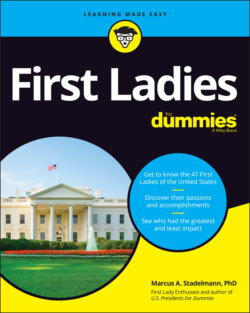Читать книгу First Ladies For Dummies - Marcus A. Stadelmann, Marcus A. Stadelmann PhD - Страница 23
Phase III (1869–1933)
ОглавлениеThe role of First Lady changed again after 1869. Suddenly, there were no more youthful surrogates being used as First Ladies. The new First Ladies came from different backgrounds compared to the First Ladies in Phase I. The ladies discussed in Part 4 weren’t married to founding fathers nor were they the wives of rich plantation owners. However, they were well educated, and many came from small-town America.
The press started talking about the First Ladies reflecting the ideal of the new woman. The new woman was educated, as universities had opened up enrollment to women. The new woman was also involved in political organizations. The Civil War had gotten many women involved in public organizations, and all female political and social clubs were founded.
Many political and social barriers were broken down during this period. Some political gains happened, too. Women got the right to vote at the local and state level, and the country saw its first female politicians elected at the local level. Some women were even appointed to state and local government positions. By 1900, women could vote in four states: Wyoming, Idaho, Colorado, and Utah. Even though women still had to attach themselves to their husband’s career, many spoke out in public and created and joined national organizations. Not surprisingly, the suffrage movement gained steam, too, and by 1917, the first female member of Congress, Jeannette Rankin from Montana, was elected.
With the outbreak of WWI, the role of women and First Ladies changed yet again. After becoming a part of the war effort, women suddenly stayed a part of the workforce and in 1920 received the right to vote at the presidential level. Florence Harding was the first woman to cast a ballot for her husband in 1920. Right before, Edith Wilson basically became the president herself after Woodrow Wilson suffered a debilitating stroke. She became his guardian and gatekeeper and studied every paper and decided what would go to the president and what wouldn’t. In other words, she became responsible for policy making, and letters sent to her addressed her as “Mrs. President.”
